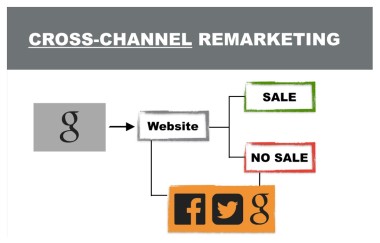A recent survey by Profoundry, reported that only 8% of startups outsource their marketing to a consultant or an agency and 65% of startups have never received nor considered any formal digital marketing training. With the added pressure of being funded, startups have to find the right balance between what makes sense from a digital marketing point of view and what will please investors and venture capitalists.
Here are five of the biggest digital marketing mistakes made by startups and how to fix them.
#1 Pilots and Year-Long Marketing Plans
Investors like to see progress and a strategic approach to growing businesses. Frequently, startups that are funded or are looking to get a VC on board create a 9-12 month marketing plan. That plan usually consists of a three-month pilot phase and two or three expansion phases.
Online advertising changes fast and new ad formats come out every 8-12 weeks, meaning you are planning ahead without considering any new ad formats. Additionally, one of the biggest characteristics of online marketing versus offline marketing is that the all important split tests show nearly instantaneous results. Planning a year ahead without ever having tested anything means basing everything on assumptions about what works best. While you can estimate conversion rates and costs based on experience, to estimate a year ahead and have that plan go through exactly as expected without discovering a better way of doing things is unlikely.
Examples of a recent ad format that throw many businesses off recently is the call-only ad format on Google AdWords. Many businesses were caught by surprise when Google pulled the option to target mobile devices exclusively and introduced the bid modifier. Some businesses started click-to-call ads and exactly those businesses recently had to make the choice whether they wanted to call-only ads a shot. If any of those businesses has made a 12 months plan, none of those changes would have been in it.
A reactive, flexible, and adjustable digital marketing strategy works far more effectively for a fast growing startup. Decide what platform you want to try first and how much money you are willing to spend even if you don’t get a single lead or sale. Start advertising the top three product or service, meaning the ones where you expect the highest demand and/or highest margins. Once that works out, add a complementary platform with for cross-channel remarketing purposes and if that works, add a campaign on that second platform.
#2 Budgets Versus Costs
Investors (or some clients that are new to online marketing if you are an agency) want to see the exact budget for the next 3 months, the following 4 months, and so on. Most of the time, that budget is nowhere near accurate. Additionally, while there is always the expectation of the magical boost to the bottom line, when the first online marketing proposal is looked at, the budget is often considered as cost. But you need to separate budget, actual campaign spend (which is indicated in 99% of platforms as “cost”), and actual cost, meaning the cost of people working on the campaign.
Additionally, it is a great time to point out that online marketing budgets are meant to be an investment. They are meant to generate profit, directly with sales or indirectly with branding. The difference in wording here makes a big difference because everyone knows that investments have a certain level of risk to them. So if need to evaluate or present your marketing plan, keep in mind what the different numbers stand for.
Depending on what kind of business you are in, also consider the expected lifetime value of a customer. Especially if you are funded and have about a year to make an epic fail or make this the best decision you’ve ever made.
Again, this depends on how often customers buy. This strategy is great if you have more than one purchase per customer within a year and terrible if you are planning on selling something like high-end laundry machines or kitchens that people buy every 10 years.
#3 Using More Than One Platform Straight Away
Starting with multiple platforms at once is a typical digital marketing mistake of startups and is also one of the topics that marketers fight about the most. While some wholeheartedly support starting with as many platforms and campaigns as your budget allows for to get to success faster, others prefer to start small and scale it up. From my experience, there are advantages and disadvantages for both strategies but my recommendation would be to start small and scale it up – always.
If you start Facebook, AdWords, Bing, Twitter, Pinterest, and so on all at once, you will know a lot faster what doesn’t work and can focus on what works better or keep testing until you make it work for all platforms. While I am all for black and white decision-making and having clear stats that point me in the right and obvious direction, it’s a lot of work to set up and there is a more efficient way to do this.
Businesses can be sorted in two types of digital marketing categories:
- Push-Marketing
- Pull-Marketing
Advertising platforms typically fit either or. There are a few platforms that are great for both strategies but the main traffic a platform can generate typically comes from just one of those strategies. Let’s have a look at a couple of examples.
For 99% of pull strategies, keyword driven platforms like, AdWords and Bing, for example are your best bets.
For push, it is a little more than that. Interests, behaviors, demographics fit most customer profiles for push marketing strategies, so Facebook and the Google Display network are great options here. Additionally though, there are other categories like social proof for instance. People buy from you mainly because of who else bought from you and what reviews are saying.
The latter matters in particular to tech startups and companies that sell an innovative product. Think of the patented pillow with a hoodie that was featured on Shark Tank a while back, for instance. This is the kind of product people walk past in the store and didn’t even knew they needed because it didn’t exist before.
Options for online advertising should be target keyword based, meaning potential customers that are looking for gifts or decorative pillows for instance, or to target age groups, lifestyles (e.g. ages 17-23, currently in college), and the like.
By being very clear about push and pull marketing, you can compare what the different platforms can offer for the startup in question. If you have to go for one, take the one with the biggest volume and the least variables.
Instead of trying all platforms at once, you can narrow it down to the ones more likely to serve your marketing strategy. Once you find out what works, you will be able to nearly duplicate the campaign for another platform from the same marketing category. For instance, if your product is demand driven, your marketing strategy is pull. If Google AdWords works out, Bing will most likely be profitable also.
Besides the fact that you can scale campaigns up more quickly, you also develop a point of reference in just a few weeks. You know what conversion rate can be expected and what a good or bad CTR look like.
Trying all platforms at once quickly throws out a wide variety of CTRs and conversion rates, not to mention costs per click, and evaluating what metrics are good or bad and how much they can improve in what time frame is not always straight forward. Testing one platform after the other, on the other hand, will quickly give you numbers you can compare other campagins to.
If you start with AdWords and have a limited budget, you can test Bing and see whether it makes more sense to work on both or whether it makes more sense to spend it all on AdWords, or even try another platform.
#4 Not Starting Cross-Channel Remarketing ASAP
Remarketing, also known as retargeting, means targeting people who didn’t convert. It is also known for high conversion rates at low costs per conversion. What is genius about cross-channel remarketing is that you can dramatically increase conversion rates and introduce an additional platform within the first month or two, depending on how much traffic you are getting.
The process of remarketing:
- People click on an ad, let’s say on Google
- They don’t convert
- You show them ads again on Google
- Some of them convert at a great price
- Repeat
The process of cross-channel remarketing:
- People click on an ad, let’s say on Google
- They don’t convert
- You show them ads again on Google and Facebook and Twitter
- Some of them convert at a great price
- People think the brand is huge because they see the business everywhere
- Repeat
In brief, cross-channel remarketing targets people who didn’t convert with a different platform. So instead of running a campaign with Google AdWords and using a remarketing campaign to target people again via Google, you would target those people via a Facebook cross-channel remarketing campaign. This is genius especially for startups because you can take the advantages of keyword based platforms like Google or Bing – which are demand driven and often have a lot of traffic to offer – and combine them with behavior and interest based platforms such as Facebook. Therefore, people who came to your website via Google and clearly looked for what you are offering, will now see your ad on Facebook, surrounded by photos of their friends and family.
This is genius especially for startups because you can take the advantages of keyword based platforms like Google or Bing – which are demand driven and often have a lot of traffic to offer – and combine them with behavior and interest based platforms such as Facebook. Therefore, people who came to your website via Google and clearly looked for what you are offering, will now see your ad on Facebook, surrounded by photos of their friends and family.
Here are the three steps of cross-channel remarketing:

In the graphic above, you see the traditional remarketing on Google AdWords. Potential customers that clicked the AdWords ad but didn’t convert are targeted again with AdWords.

Above is an example of what you can do to get started with cross-channel remarketing. If you are already advertising on Google, you can retarget potential customers who came via AdWords and didn’t buy with a cross-channel remarking campaign on Facebook.

The ‘g’ in the graphic above indicates Google AdWords and shows the cross-channel remarketing strategy that many businesses choose: driving keyword-based traffic with Google AdWords and then retarget with Google AdWords, Facebook, and Twitter.
Advantages of Cross Channel Remarketing
Potential customers don’t know why they are seeing your ad everywhere all of a sudden and think you are a huge company with a never-ending budget. Furthermore, they see your ad in a different setting they associate with personal connections, friends, family, and other trusted people or brands.
Remarketing results boosted? Check. Remarketing traffic increased? Check. Positive branding side-effect? Check. Sneaking in traffic from large platforms like Facebook and Twitter but targeting people who are actively looking for your product or service? Check. Gotta love this!
#5 Rushing Through Funnel Split Tests
Before I go into funnel split test best practices, I would like to share why this topic is in my top five points in the first place. When my husband and I started our first businesses, we noticed quickly that what could really speed up our entrepreneurial learning curve was a mentor. A person who had been there, done that, and had most of all developed a systematical approach to making businesses successful over and over again.
What we wanted wasn’t that one company that was going to be the next Facebook, but about a dozen highly profitable businesses that would allow us to live a digital nomad lifestyle and make all of our materialistic dreams possible. While we were doing ok for the first couple of months, the breakthrough came when we took on a new client that put a rather harsh perspective on our lives. Early twenties, worth hundreds of million, self-made, never even finished high-school – most importantly, it didn’t all come from one company but several companies and (to our surprise) completely different industries.
His secret: test, test, test.
While this sounds simple, the level of detail things are tested in this guy’s campaigns is something I had never seen anywhere else and we now approach every campaign as well as every business with this testing concept. To give you an idea of how important testing is, each ad group tests a minimum of 25 ads a day and for each product or service, a minimum of 80 landing pages are created simultaneously.
What This Means for Funnel Split Tests of Startups
Online marketing split tests can mean testing landing pages, campaign structures, keyword match types, audiences, and more. While most people test all of these things eventually, one of the things that make the biggest difference to the conversion rate is split testing the sales funnel which is often overlooked or rushed through.
Of course, the sales funnel should be as short as possible and each of the steps should be tested after one another. Most of the time, the step in the funnel that makes the biggest impact on the conversion rate is the one right before or right after inserting the payment information, so if you don’t know where to start, experiment with these two.
Instead of letting a campaign run and then start testing, set up the campaign already with the first split test and a scalable campaign structure so once you find what works, you can increase the budget and get more of the same traffic quickly.
In Conclusion
Digital marketing mistakes can be costly. While there are different ways to keep costs low and set up profitable campaigns, I have found that the points listed above significantly impact the success of campaigns of fast growing startups – more so than other aspects.
Image Credits
Featured Image: Illustration via Christina Baldassarre.
In-post Photots: Illustrations via Christina Baldassarre.





![AI Overviews: We Reverse-Engineered Them So You Don't Have To [+ What You Need To Do Next]](https://www.searchenginejournal.com/wp-content/uploads/2025/04/sidebar1x-455.png)